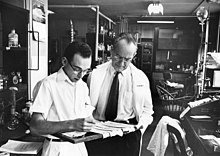Irvine Page
Irvine Page | |
|---|---|
 Page (right) and lab tech in the 1960s | |
| Born | Irvine Heinly Page January 7, 1901 |
| Died | June 10, 1991(aged 90) |
Irvine Heinly Page(January 7, 1901 – June 10, 1991) was an Americanphysiologistwho played an important part in the field ofhypertensionfor almost 60 years while working at theCleveland Clinicas the first Chair of Research.[1][2][3]
Early life and education[edit]
Irvine Page was born on January 7, 1901, in Indianapolis, Indiana. He attended college atCornell University,with an undergraduate degree in chemistry (1921) and an M.D. degree in 1926.[4]Page completed his internship atPresbyterianandBellevue Hospitalsin New York City.[5]
Career[edit]
After completing his internship, Page then performed research inphysical chemistryat Woods Hole and then New York. In 1928 he joined theKaiser Wilhelm InstituteinMunich,Germanywhere he started a new department ofneurochemistry.With the coming rise to power ofHitler,Page left Munich in 1931 to work withDonald Van SlykeatThe Rockefeller Institute for Medical Researchin New York City. He worked at the Rockefeller Institute through 1937. Page then moved back to Indianapolis as Director of the Laboratory for Clinical Research atEli LillyatCity Hospital.In 1945, Page then organized a new research division at theCleveland Clinic.[5]
His first contributions were published in the early 1930s and his most recent, "Hypertension Research: A Memoir: 1920–1960", in 1988. He is perhaps best known for the co-discovery ofserotoninin 1948,[6]although his pre-eminence is a matter of record in four other areas: therenin–angiotensin system,the mosaic theory of hypertension,[7]treatment of hypertension and public and professionaladvocacyof the recognition of this condition and its effects in daily life. In earlier work he published on theneurochemistryof thebrain.
Page received many honors for his work. He was on the cover of Time magazine in 1955.[8]He was president of theAmerican Heart Association(1956–57); he received tenhonorary degreesand a number of prestigious awards—the Ida B. Gould Memorial Award of theAmerican Association for the Advancement of Science(1957); AlbertLasker Award(1958);Gairdner Foundation International Award(1963); Distinguished Award of theAmerican Medical Association(1964);Oscar B. Hunter Award(1966); Golden Plate Award of theAmerican Academy of Achievement(1966);[9]Passano FoundationAward (1967); and the Stouffer Prize (now theNovartisAward) for Hypertension Research in 1970. He was elected to theNational Academy of Sciencesin 1971 and published his memoirs in 1988.
The American Heart AssociationIrvine H. Page Young Investigator Research AwardArchived2007-09-27 at theWayback Machineand theIrvine Page – Alva Bradley Lifetime Achievement Awardare named in his honor.
Later life[edit]
A collection of his papers is held at the National Library of Medicine in Bethesda, Maryland.[10]
Personal life[edit]
He was married to Beatrice Allen, a dancer, poet, and author of the book, The Bracelet. His sister wasRuth Page,a noted American ballet dancer. Page was also a gifted musician, a trait he passed on to his two sons, Christopher Page and Nicholas Page. Page lived in Cleveland, OH with his wife and children, summering in Hyannis Port on Cape Cod. His family home on the Cape is now owned and occupied by his granddaughter and great-grandchildren.
Death[edit]
Having retired to Hyannis Port, Massachusetts, Page died suddenly on June 10, 1991, at the age of 90. He had been previously injured in an auto accident in March 1990 and suffered from poor health due to a prior stroke and a prior heart attack.[3]
Selected publications[edit]
- Page, Irvine (1987).Hypertension Mechanisms.Orlando, Fla.: Grune & Stratton.ISBN978-0-8089-1768-7.
- Page, Irvine (1988).Hypertension Research: A Memoir: 1920-1960.New York: Pergamon.ISBN978-0-08-036079-9.
- Page, Irvine (1937).Chemistry of the brain.New York: C.C. Thomas. ASIN B-000-87D23-C.
- Page, Irvine (1972).Speaking to the Doctor: His Responsibilities and Opportunities: Selected Editorials from Modern Medicine.Minneapolis: Proforum.
Footnotes[edit]
- ^Dustan, HP(1990). "Irvine Page lecture. Legacies of Irvine H. Page".Journal of Hypertension Supplement.8(7): S29–34.PMID2095393.
- ^Dustan HPIrvine Heinly Page.Archived2011-06-07 at theWayback MachineThe National Academies Press Biographical Memoirs.
- ^abFrohlich ED,Dustan HP,Bumpus FMIrvine H. Page: 1901-1991. The Celebration of a LeaderArchived2020-04-11 at theWayback MachineHypertension 1991;18:443–445.
- ^"weill cornell medicine"(PDF).Archived(PDF)from the original on 16 June 2022.Retrieved6 July2024.
- ^abGifford, R. (January 1987)."Profiles in cardiology: Irvine h. page".Clinical Cardiology.10(1): 68–69.doi:10.1002/clc.4960100117.PMID3545576.
- ^Rapport, MM; Green, AA; Page, IH (1948)."Serum vasoconstrictor (serotonin). IV. Isolation and characterization".J Biol Chem.176(3): 1243–1251.doi:10.1016/S0021-9258(18)57137-4.PMID18100415.
- ^Page, IH (1967). "The mosaic theory of arterial hypertension--its interpretation".Perspectives in Biology and Medicine.10(3): 325–33.doi:10.1353/pbm.1967.0031.PMID6034593.S2CID29576640.
- ^issue
- ^"Golden Plate Awardees of the American Academy of Achievement".achievement.org.American Academy of Achievement.Archivedfrom the original on 2016-12-15.Retrieved2020-05-12.
- ^"Irvine H. Page, M.D. Papers 1917–1989".National Library of Medicine.
External links[edit]
- Cornell University alumni
- American physiologists
- 1901 births
- 1991 deaths
- American medical researchers
- Recipients of the Albert Lasker Award for Basic Medical Research
- Members of the United States National Academy of Sciences
- 20th-century American scientists
- Scientists from Indiana
- People from Indianapolis
- Cleveland Clinic people
- Members of the National Academy of Medicine
- Members of the Royal Swedish Academy of Sciences
